Book by Geoffrey R. Stone
The difficult balance between liberty and security … when do unwanted or unpopular ideas actually pose a danger?
Free expression is the “indispensable condition” for our other basic freedoms.[1] But what happens in wartime when this cherished right collides violently with national security? Do our constitutional rights ebb and flow with each conflict, or do they remain static and stoic in the face of seemingly existential crises? In Perilous Times: Free Speech in Wartime, Geoffrey Stone surveys United States history during six periods of actual or imminent war, from the Alien and Sedition Acts of 1798 to Vietnam, to draw instructive lessons on our reactions, and overreactions, to wartime speech.[2] His thesis: During times of war as passions rise and threats loom, both government and citizens take actions that, with the benefit of hindsight, exceed necessity and threaten individual liberties. Stone’s compelling argument offers timeless lessons for legal professionals about the intersection of free expression and national security. This problem does not belong to history; indeed, the Global War on Terrorism (GWOT) presents the latest installment.
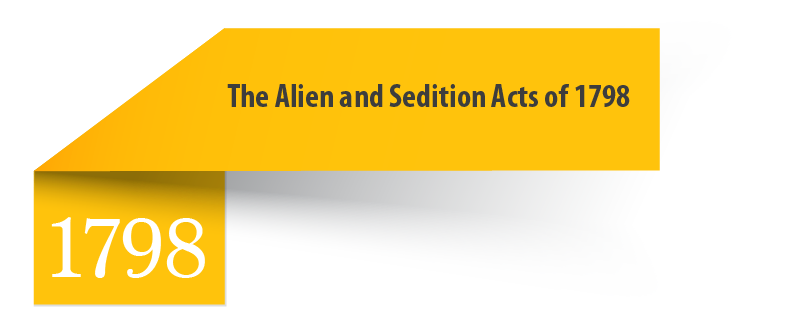
The Alien and Sedition Acts of 1798
The two primary parties in the early Republic, the Federalists and the Republicans, viewed the French Revolution through their ideological lenses: Republicans (who valued liberty over security) lauded a principled stand against an unjust government, while Federalists (taking the opposite approach) saw merely chaos.[3] As tensions rose with France (America’s then-recent ally) over repeated slights, the Federalists raised the threat of “internal subversion”—a theme seen time and again—and conflated Republican dissent with disloyalty.
Congress responded with legislative measures known as the Alien and Sedition Acts.[4] The Alien Enemies Act allowed wartime deportation or confinement of an enemy nation’s citizens.[5] The Alien Friends Acts allowed detention and deportation of any noncitizens deemed dangerous.[6] Finally, the Sedition Act prohibited “false, scandalous, and malicious” statements against the government made with intent to defame, bring into contempt, or excite hatred.[7] Once passed, applying the Acts raised a thorny question: When do unwanted or unpopular ideas actually pose a danger? In this fevered atmosphere, the federal bench became an ally against sedition (read: Republicanism).[8]
War fervor can lead to overreaction. Not only can Congress craft disproportionate solutions to legitimate problems, but parties may use national security threats for partisan ends.
This period showed how war fervor leads to overreaction. Not only can Congress craft disproportionate solutions to legitimate problems, but parties may use national security threats for partisan ends. In such moments of high anxiety, judges and juries may not protect civil liberties. Finally, the Acts reveal the elusive line between legitimate and malicious dissent. When this line is unclear, the mere threat of prosecution chills the willingness to criticize. Though the author underplays the procedural uncertainty and substantive threat facing the young nation, he convincingly lays out the key themes that resonate through these six periods and beyond.
During the American Civil War, free speech ideals collided with reality.
The Civil War
During the American Civil War, free speech ideals collided with reality. Fought from 1861 to 1865, the Civil War presented an existential threat to the nation. Facing riots in Baltimore and threats to key rail links with the North, President Abraham Lincoln suspended the writ of habeas corpus in areas of Maryland blocking access to Washington, D.C. The Constitution states that, “The privilege of the writ of habeas corpus shall not be suspended, unless when in cases of rebellion or invasion the public safety may require it.”[9] The “great writ” offered a “fundamental instrument for safeguarding individual freedom against arbitrary and lawless” government action; its suspension removed the ability of citizens to challenge their detention in court.[10]
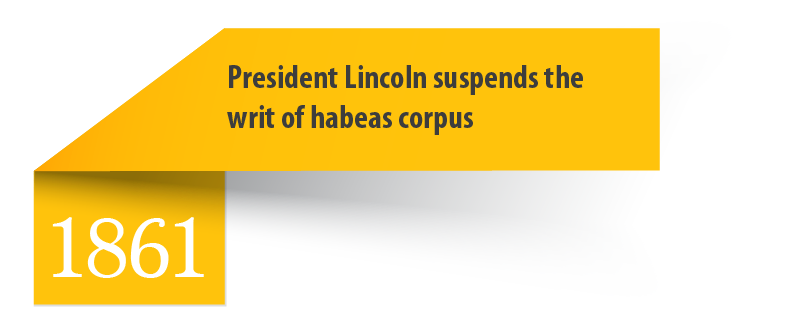
In Ex parte Merryman, Chief Justice Roger Taney ruled that the President could not suspend the writ, a power delegated solely to Congress.[11] Lincoln ignored the ruling, arguing that the “war power” and his role as Commander in Chief imbued him with authority to defend the nation against imminent destruction. To forbid him this power would allow “all the laws, but one, to go unexecuted, and the government itself go to pieces, lest that one be violated.”[12] Without the writ, military authorities were central to law and order. They arrested between 13,000 and 38,000 civilians during the war,[13] and commanders exercised their authority in widely divergent ways. As former Chief Justice Rehnquist wrote, “statements critical of the government¼were punished by fine and imprisonment¼. Martial Law was the voice of whichever general was in command.”[14]
The Civil War raised questions of persistent relevance. Do the ordinary guarantees of free speech bend in the face of threats to the government?
The Civil War raised questions of persistent relevance. Do the ordinary guarantees of free speech bend in the face of threats to the government? Are judges even capable of making this determination, or should it remain an executive prerogative? Ultimately, the author concludes that Lincoln, faced with an unprecedented and existential crisis, took prudent and limited action to curtail free speech, though he failed to control excesses wrought by military commanders. Even recognizing the grave nature of the danger, the author downplays the precedential danger of the executive ignoring a mandate from the judiciary.
World War I
The United States resisted entering World War I (WWI) for three years until 1917, when German targeting of neutral shipping led to war. President Woodrow Wilson, raising the specter of active foreign subversion—just as Federalists had over a century earlier—established a committee that effectively conscripted public opinion for war.[15] A tip line yielded thousands of daily accusations of “disloyalty.” In this environment, Congress passed the infamous Espionage Act of 1917 and Sedition Act of 1918.
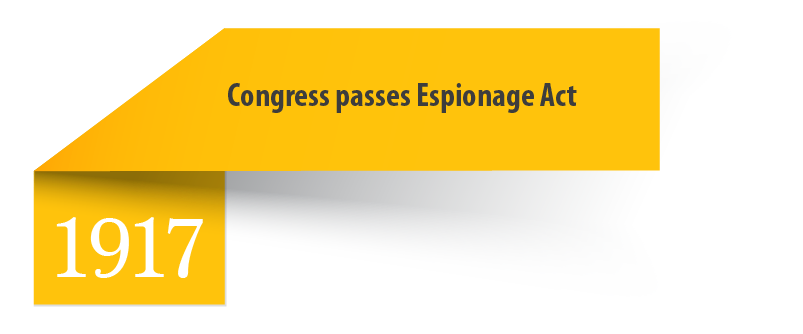
The Espionage Act broadly criminalized speech: it banned false statements that interfered with military success, prevented persons from causing or attempting to cause insubordination, and forbade obstruction of recruiting and enlistment activities. The Sedition Act barred disloyal or abusive language about the government.
Swept up in the wartime mood, courts loosened standards and held that speech need only have a “bad tendency” to cause insubordination …. “War fever turned dissent into disloyalty, and disloyalty into crime.”
Swept up in the wartime mood, courts loosened standards and held that speech need only have a “bad tendency” to cause insubordination.[16] Stunning results followed. For instance, a Russian immigrant stated that “I am for the people and the government is for the profiteers” during an antiwar rally. There were no soldiers (and, in fact, no men) present, but she nonetheless received a ten-year sentence.[17] In essence, opposition to the war equated to obstructing the war: “War fever turned dissent into disloyalty, and disloyalty into crime.”[18]
Beginning with President Wilson, the government enthusiastically bent to public demands and wielded the sword of justice without discretion. The author faults the executive branch officials enforcing the Acts, but reserves special ire for the federal judiciary, including the Supreme Court, for its rash interpretation and application of the law, as well as the approval of unconscionably long sentences.[19] Following the war, Congress repealed the Sedition Act. Most prisoners had their sentences reduced and were freed. While the excesses were quickly recognized, this dark chapter nonetheless remains a cautionary tale. The author not only captures these excesses well, but returns to them to pose the question we still cannot answer: Why don’t these lessons last longer?
Fascism and communism spurred popular fear in the years before World War II (WWII).
World War II
Fascism and communism spurred popular fear in the years before World War II (WWII). Unlike WWI, the forced entry following the attack on Pearl Harbor galvanized the nation. This led to very different results. Though Congress passed the Smith Act, which required alien registration and restricted advocacy against the government, only two wartime prosecutions resulted.[20] Meanwhile, the Supreme Court continued, and even accelerated, a speech-protective shift. Of note, in West Virginia State Board of Education v. Barnette, the Court held schools cannot require children to salute and pledge allegiance.[21] Justice Jackson, with rhetorical flourish, wrote that “If there is any fixed star in our constitutional constellation, it is that no official, high or petty, can prescribe what shall be orthodox in politics, nationalism, religion, or other matters of opinion¼.”[22]
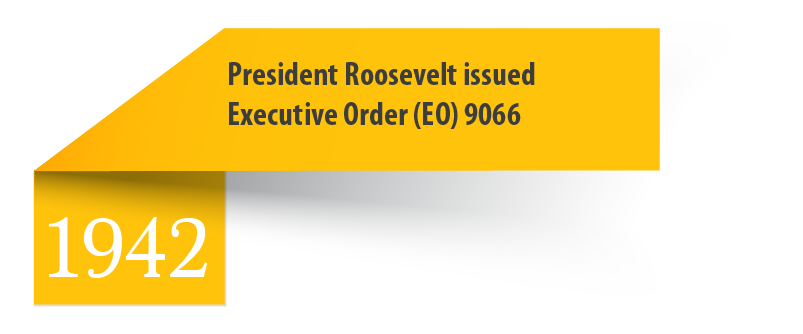
Yet the period was not free of wartime overreactions. In 1942, President Roosevelt issued Executive Order (EO) 9066, authorizing the Army to exclude people from designated “military areas.” In Korematsu v. United States, the Court upheld an exclusion order that interned anyone of Japanese ancestry, regardless of citizenship.[23] The majority cast the measure in light of wartime necessity, rather than race. In dissent, Justice Frank Murphy questioned the rationale for differential treatment of the Japanese.[24] He wrote, “I dissent, therefore, from this legalization of racism.”[25] Time vindicated the dissent and exposed the exclusion’s folly. A 1983 commission reviewed the evidence supporting the policy. It found fabricated assertions, concluded that the most dangerous individuals were already in custody, and revealed that senior military figures assessed the risk of Japanese attack on the West Coast as virtually zero.
World War II saw less repressive government action with regard to speech. Prosecutions for disloyalty were rare and DOJ officials applied the laws with discretion. The Supreme Court increased its protections on speech and association. However, the Court, and the nation, cannot erase the racist treatment of Japanese citizens. This dark hour where, with the military’s complicity, ancestry became a sole reason for detention, will remain a chilling reminder of excess. The author sets up the stark contrast with World War I. Yet in this section, and throughout the work, his attempts to explain systematic causes for period-to-period differences in wartime speech are unsatisfying and forced. Perhaps the reasons are too complex for reductive explanations.
President Harry Truman’s EO 9835 established a loyalty program: a “reasonable belief” that a person would be disloyal meant termination or denial of federal employment.
Cold War
Though 1945 brought victory in WWII, the United States quickly entered a new “Cold War” with its erstwhile ally, the Soviet Union. “Loyalty” became the defining issue in politics. Fear burrowed relentlessly into the American psyche. Politicians and government officials vigorously pursued communists or “fellow travelers” for either present or past beliefs.[26]
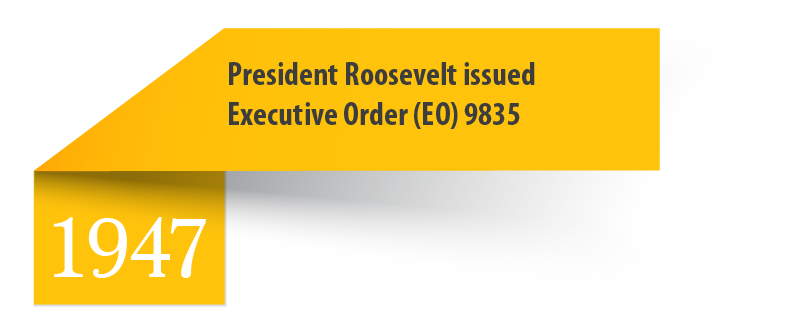
President Harry Truman’s EO 9835 established a loyalty program: a “reasonable belief” that a person would be disloyal meant termination or denial of federal employment. Little due process existed. The results: 4.7 million Americans were investigated, 350 were discharged, and exactly zero cases of espionage or subversive malfeasance were found.[27] Even if cleared, those investigated faced personal and professional repercussions.
Congress was not immune. The McCarran Internal Security Act required registration of all communist organizations and allowed detention, without judicial review, of any person who might participate in “acts of espionage or sabotage.”[28] Meanwhile, the House Un-American Activities Committee (HUAC) tarred respondents with “guilt by association.” But the emblematic figure of the era was Senator Joseph McCarthy of Wisconsin. He fueled the hysteria by producing fabricated “lists” of avowed communists in and out of government. In time his excesses became evident, yet the author reminds us that, for several years, he rode a tidal wave of popularity that met with little resistance. Leaders might shake their heads, but few stood up to this juggernaut.
The Supreme Court had a mixed record. In a 1951 decision that encouraged “red hunters” nationwide, the Court upheld convictions for conspiring to advocate the overthrew of the government (rather than so advocating).[29] Yet by 1957 the Court evolved and held that advocacy of forcible overthrow alone is not enough—without some effort to bring about that end the advocacy was “[t]oo remote from concrete action.”[30] More speech protective decisions followed: the Court invalidated a statute requiring state employees to swear they did not belong to an organization advocating violent government overthrow;[31] granted an as-applied challenge to a statute requiring out-of-state associations to disclose membership lists;[32] and reversed a labor leader’s conviction for refusing to answer HUAC’s questions on the political activities of former Communist members.[33]
The author laments a stunning decline in support for civil liberties, even among those tasked with their preservation—the press, politicians, lawyers, courts, and educators. The failure was pervasive. Voices for suppression enjoyed broad support in combatting what, in retrospect, was as a minor threat to the government. The true threat came from this erosion of core rights: instead of focusing on espionage from a law enforcement perspective, the country instead stifled open debate and fostered “a climate of fear and timidity.”[34]
A key concern the Vietnam Era raised: How can the public, or, indeed, Congress, act as a check against excessive monitoring when the scale and scope of monitoring are unknown to them?
The Vietnam War
The Vietnam War (1955-1975) grew in controversy as it gradually escalated. By the late 1960s, widespread demonstrations, bombings, and building takeovers dominated the news. The government raised the specter of subversion by linking protests to possible communist influence. This translated to extensive domestic surveillance and active steps against the anti-war movement. For instance, the FBI, CIA, NSA, Army Intelligence, and even the IRS were harnessed to monitor and thwart the anti-war movement.[35]
Yet the Supreme Court protected dissent vigorously during this period. The Court upheld students’ right to wear black armbands to protest the Vietnam War.[36] It rejected the Georgia House of Representatives action to prevent a duly elected representative from taking a seat because he endorsed statements criticizing the draft.[37] And it struck down a ban on wearing military uniforms in a theatrical production that tended to discredit the armed forces.[38] Looking back through history, the Court would have upheld these cases. Yet the Court had come to understand the necessity of protecting speech at the margin.[39] The Vietnam era demonstrates that courts, when focused on applying First Amendment protections in spite of popular mood, can serve as a bulwark against excess. The author deserves praise for presciently identifying a key concern the Vietnam Era raised: How can the public, or, indeed, Congress, act as a check against excessive monitoring when the scale and scope of monitoring are unknown to them? This resonates profoundly today.
The author suggests that each generation’s notion of “dangerous” speech, seemingly justified at the time, rarely survives retrospective scrutiny.
Perilous Times: Redux
The author suggests that each generation’s notion of “dangerous” speech, seemingly justified at the time, rarely survives retrospective scrutiny. And when government panders to baser instincts for political gain, liberty comes under threat. As Judge Learned Hand wrote, “Liberty lies in the hearts of men and women. No law can save what dies there.”[40] The broader public must acknowledge liberty’s value or it dissipates during wartime. Congress, though it sometimes acted with restraint, often failed to check public hysteria.
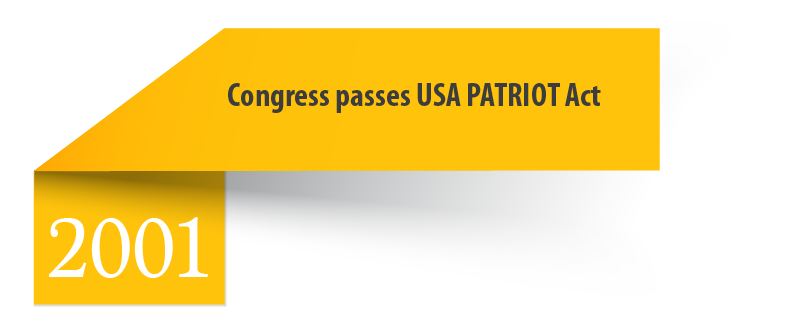
These issues continue to resonate. This 2004 book only briefly addresses the challenges of the GWOT. The attacks of September 11, 2001, forced a reckoning on the balance between liberty and security. In October 2001, the USA PATRIOT Act altered this balance.[41] This 300-page Act included provisions authorizing indefinite detention of immigrants; allowed law enforcement to conduct “sneak and peek” warrants with delayed notification; expanded the use of National Security Letters, which allowed the FBI to search phone, email, and financial records without a court order; and expanded access to business records.
Every generation facing tension between liberty and security has said, “This time is different.”
The following years, more familiar to today’s readers, saw legal and political challenges to the breadth of the Act. The Supreme Court struck down indefinite detention of immigrants, requiring the government to provide the opportunity to challenge enemy combatant status.[42] This may have seemed like an abstraction to most citizens, but Edward Snowden’s 2013 revelations regarding, among other things, the depth of National Security Agency (NSA) surveillance programs, including bulk telephone record collection, made the problem concrete.[43] In 2015, the USA Freedom Act ended this practice without court authorization.[44]
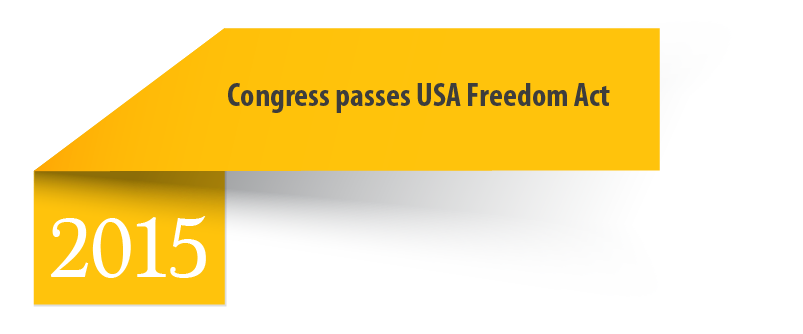
How have we fared over the past 18 years? Certainly, terrorism presents a different challenge than the large-scale wartime conflicts described above; perpetrators, sometimes tied to terrorist groups and sometimes inspired by such groups, are difficult to detect, identify, and counteract. But as legal professionals who will help shape the future of national security law, we must ask ourselves if this challenge is so different that old lessons do not apply. Every generation facing tension between liberty and security has said, “This time is different.” Congress, on behalf of a justifiably angry, wounded, and fearful nation, passed sweeping legislation 70 days after the attacks of September 11. In the moment, assessing risk and crafting moderate solutions are hard. The hope is that politicians, and indeed the public, can recognize excess and adjust the balance accordingly. Yet this only works with transparency: when secrecy in the name of security obscures public view, can we assess the balance of liberty and security without knowing the full picture?
When secrecy in the name of security obscures public view, can we assess the balance of liberty and security without knowing the full picture?
Conclusion
The author’s presentation is highly readable and well argued, but also extensively sourced for anyone that wants to dive into the weeds. While his conclusions are debatable, they provide excellent food for thought on a challenge that will recur. His key messages are worth internalizing. History is unkind to the wartime curtailment of liberty in the interest of security. Congress and the Executive, motivated by an urge to protect, may threaten the liberties that animate our great nation. We also see that courts were not immune to wartime pressures. Results-oriented approaches yielded convictions unsupported by law or evidence. As legal professionals, we may find ourselves in a position to influence this debate, whether in or out of the military. Let us keep these lessons in mind when striking the difficult balance between liberty and security.
EXPAND YOUR KNOWLEDGE
External Links to Additional Resources
About the Reviewer

Captain Matthew Blyth, USAF
(B.A., Vanderbilt University; J.D. St. Mary’s University School of Law) is an Area Defense Counsel at Joint Base San Antonio – Randolph, Texas.
[1] Palko v. Connecticut, 302 U.S. 319, 326–27 (1937).
[2] Geoffrey Stone, Perilous Times: Free Speech in Wartime (Norton 2004).
[3] Id. at 25.
[4] Congress fought bitterly over the Acts. The recently-ratified Constitution’s meaning was unclear on critical matters, including the First Amendment’s breadth, or whether it even protects noncitizens. (It does.)
[5] This remains law. See 50 U.S.C. § 21–24
[6] An Act respecting Alien Enemies, 5th Cong, 2d Sess, ch 66 (1798).
[7] An Act for the Punishment of Certain Crimes against the United States, 5th Cong, 2d Sess, ch 74 (1798).
[8] Stone, supra note 2, at 44.
[9] U.S. Const art.1, §9, cl. 2. Note that Article I enumerates the powers of Congress, not the executive. Until the Civil War, the writ was suspended only twice — both in brief and localized circumstances. Stone, supra note 2, at 120.
[10] Harris v. Nelson, 394 U.S. 286, 290–91 (1969).
[11] 17 F. Cas. 144 (D. Md. 1861) (No. 9,487).
[12] Stone, supra note 2, at 122 (emphasis added).
[13] Id.
[14] William H. Rehnquist, All the Laws But One: Civil Liberties in Wartime 73–74 (Knopf 1998).
[15] Caryn E. Neumann, Committee on Public Information, https://www.mtsu.edu/first-amendment/article/1179/committee-on-public-information (last visited July 1, 2019).
[16] Stone, supra note 2, at 170–71.
[17] Id. at 171–72.
[18] Id.
[19] Id. at 228. By contrast, the Sedition Act of 1798 provided for only two years maximum imprisonment.
[20] Pub L No 670, 54 Stat 670, 671 (1940).
[21] 319 U.S. 624 (1943).
[22] Id. at 642.
[23] 323 U.S. 214 (1944).
[24] No similar measures occurred with Italians or Germans, the other enemies in the War.
[25] Korematsu v. United States, supra note 23, at 244–46, 248 (Jackson, J., dissenting).
[26] Stone, supra note 2 at 319. By 1950 there were approximately 10,000 active Communist Party members, but 250,000 former members.
[27] Id. at 348.
[28] The Internal Security Act of 1950, Title II, § 103, Pub. L. 31-831, 4 Stat. 987 (1950).
[29] Dennis v. United, States, 321 U.S. 494 (1951).
[30] Yates v. United States, 354 U.S. 298, 321–22 (1957).
[31] Elfbrandt v. Russel, 384 U.S. 11, 13, 17, 19 (1966).
[32] NAACP v. Alabama, 357 U.S. 449, 462–63 (1958).
[33] Watkins v. United States, 354 U.S. 178, 197–200 (1957).
[34] Stone, supra note 2, at 374.
[35] Id. at 488–497.
[36] Tinker v. Des Moines Independent Community School District, 393 U.S. 503, 508, 510–11 (1970).
[37] Bond v. Floyd, 385 U.S. 116, 120, 133–34 (1966).
[38] Schacht v. United States, 398 U.S. 58, 63 (1970).
[39] Stone, supra note 2, at 521.
[40] Id. at 536 (quoting Learned Hand, The Spirit of Liberty, in Irving Dillard, ed, The Spirit of Liberty: Papers and Addresses of Learned Hand 189–90 (Knopf 1974)).
[41] Uniting and Strengthening America by Providing Appropriate Tools Required to Intercept and Obstruct Terrorism Act, Pub. L. 107-561, 115 Stat. 272 (2001).
[42] Hamdi v. Rumsfeld, 542 U.S. 507 (2004).
[43] Snowden Revelations, Lawfare Blog, https://www.lawfareblog.com/snowden-revelations (last visited June 5, 2019). Snowden was ultimately charged with violating the Espionage Act of 1917.
[44] Uniting and Strengthening America by Fulfilling Rights and Ensuring Effective Discipline Over Monitoring Act, Pub. L. 114-23, 129 Stat. 268 (2015).